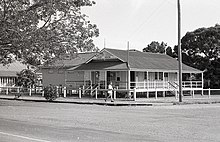
Cloncurry Courthouse is a heritage-listed courthouse at 42–48 Daintree Street, Cloncurry, Shire of Cloncurry, Queensland, Australia. It was designed by Department of Public Works (Queensland) and built in 1897 by Murray and Litster. It is also known as Cloncurry Court House. It was added to the Queensland Heritage Register on 21 October 1992.
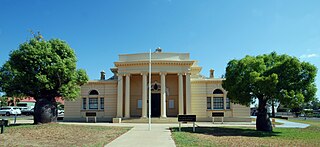
Roma Courthouse is a heritage-listed courthouse at 141 McDowall Street, Roma, Maranoa Region, Queensland, Australia. Constructed in 1901, the courthouse is a rendered masonry building, which is still in use today. Predominately influenced by the Federation free style, it is considered a stunning example of Federation colonial architecture at its best. It is also known as Roma Court House and Roma Police Buildings. It was added to the Queensland Heritage Register on 7 August 1998.

Innisfail Court House is a heritage-listed court house at 10 Edith Street, Innisfail, Cassowary Coast Region, Queensland, Australia. It is the town’s third court house. It was designed in the inter-war classical style by the Department of Public Works (Queensland) and built in 1939 by day labour. The current court house is a two-storeyed brick building with a corrugated-iron roof. It was added to the Queensland Heritage Register on 13 January 1995.

Cardwell Bush Telegraph is a heritage-listed former post office and now heritage centre at 53 Victoria Street, Cardwell, Cassowary Coast Region, Queensland, Australia. The Telegraph and Post Office at Cardwell was designed by Colonial Architect's Office and built in 1870 by George McCallum, making it one of the oldest buildings in North Queensland.
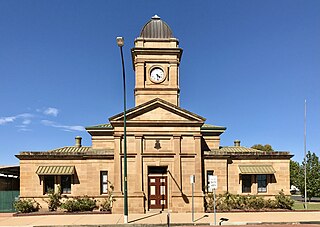
Warwick Court House and Police Complex is a heritage-listed courthouse at 88 Fitzroy Street, Warwick, Southern Downs Region, Queensland, Australia. It was designed by John James Clark and built from 1885 to 1914 by William G Conley. It was added to the Queensland Heritage Register on 21 October 1992.
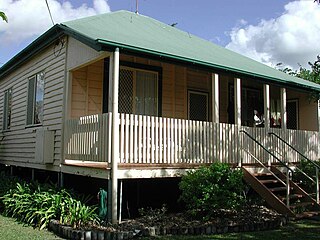
Moreton Central Sugar Mill Worker's Housing is a heritage-listed group of houses at 17 & 19 Mill Street, and 14 & 16 Bury Street, Nambour, Sunshine Coast Region, Queensland, Australia. It was added to the Queensland Heritage Register on 16 May 2008.

Bundaberg Police Station is a heritage-listed former court house (1882–1958) and former police station (1958–1997) at Quay Street, Bundaberg Central, Bundaberg, Bundaberg Region, Queensland, Australia. It was built from 1882 to 1958. It is also known as Bundaberg Court House. It was added to the Queensland Heritage Register on 1 December 1998.

The Old Butcher's shop is a heritage-listed former butcher shop at 6 North Street, Childers, Bundaberg Region, Queensland, Australia. It was built from c. 1896 to c. 1902. It is also known as HR Lassig butchers, Leatherarts, and Wrench and Thompson butchers. It was added to the Queensland Heritage Register on 21 October 1992.

Hotel Childers is a heritage-listed hotel at 59 Churchill Street, Childers, Bundaberg Region, Queensland, Australia. It was built from c. 1895 to 1930s. It is also known as Queen's Hotel. It was added to the Queensland Heritage Register on 21 October 1992.

The National Australia Bank is a heritage-listed bank building at 61 Churchill Street, Childers, Bundaberg Region, Queensland, Australia. It was designed by Hubert George Octavius Thomas and built c. 1900. It is also known as Bank of North Queensland, Bank of Queensland, and National Bank of Australasia. It was added to the Queensland Heritage Register on 21 October 1992.

Childers Ambulance Station is a heritage-listed former ambulance station at 69 Churchill Street, Childers, Bundaberg Region, Queensland, Australia. It was designed by Leonard Kempster and built in 1924 by Queensland Department of Public Works. It is also known as Childers QATB and Isis District Centre QATB. It was added to the Queensland Heritage Register on 21 October 1992.

Childers Post Office is a heritage-listed former post office at Bruce Highway, Childers, Bundaberg Region, Queensland, Australia. It was designed by Queensland Colonial Architect's Office and built from 1890 to 1910. It is also known as Childers Heritage Shop. It was added to the Queensland Heritage Register on 24 January 2003.

Federal Hotel is a heritage-listed hotel at 71 Churchill Street, Childers, Bundaberg Region, Queensland, Australia. It was built c. 1907. It was added to the Queensland Heritage Register on 21 October 1992.

Grand Hotel is a heritage-listed hotel at 106–110 Churchill Street, Childers, Bundaberg Region, Queensland, Australia. It was designed by Anton Hettrich built from 1899 to 1900. It is also known as Childers Hotel. It was added to the Queensland Heritage Register on 21 October 1992.

Queensland National Bank is a heritage-listed former bank building at 50 Churchill Street, Childers, Bundaberg Region, Queensland, Australia. It was designed by Philip Oliver Ellard Hawkes and built in 1919. It is also known as Childers Travel World, Wrench & Cobb, and Ye Olde Boutique. It was added to the Queensland Heritage Register on 21 October 1992.

Childers Pharmaceutical Museum is a heritage-listed former pharmacy and now museum at 88–90 Churchill Street, Childers, Bundaberg Region, Queensland, Australia. It was designed by F H Faircloth and built from 1902 to 1909. It is also known as Gaydon's Pharmacy and Tourist Information Centre. It was added to the Queensland Heritage Register on 21 October 1992.
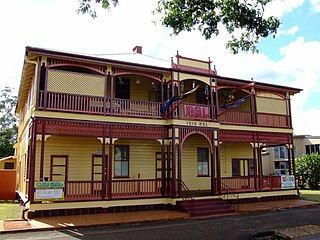
Childers RSL Club is a heritage-listed former bank and now Returned and Services League of Australia club house at 55 Churchill Street, Childers, Bundaberg Region, Queensland, Australia. It was designed by James Percy Owen Cowlishaw and built from 1900 to c. 1909. It was formerly a branch of the Commercial Banking Company of Sydney and is also known as the RSSAILA Club or the Isis RSL Club. It was added to the Queensland Heritage Register on 21 October 1992.
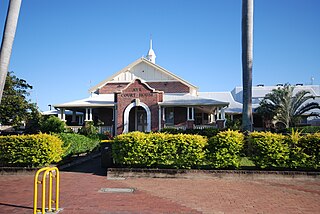
Ayr Court House is a heritage-listed courthouse at 163 Queen Street, Ayr, Shire of Burdekin, Queensland, Australia. It was designed by Douglas Francis Woodcraft Roberts and built from 1935 to 1941 by day labour. It was added to the Queensland Heritage Register on 13 January 1995.
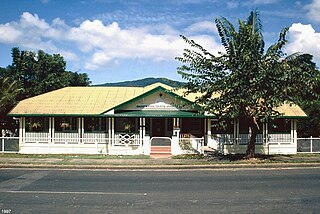
Tully Court House is a heritage-listed courthouse at 46 Bryant Street, Tully, Cassowary Coast Region, Queensland, Australia. It was designed by Nigel Laman Thomas of the Department of Public Works (Queensland) and built from 1941 to 1945. It was added to the Queensland Heritage Register on 24 September 1999.
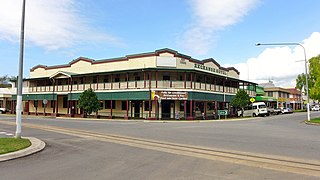
Exchange Hotel is a heritage-listed hotel at 2 Front Street, Mossman, Shire of Douglas, Queensland, Australia. It was designed by Vibert McKirdy Brown and built from 1934 to 1935. It was also known as Daintree Inn. It was added to the Queensland Heritage Register on 9 November 2012.




